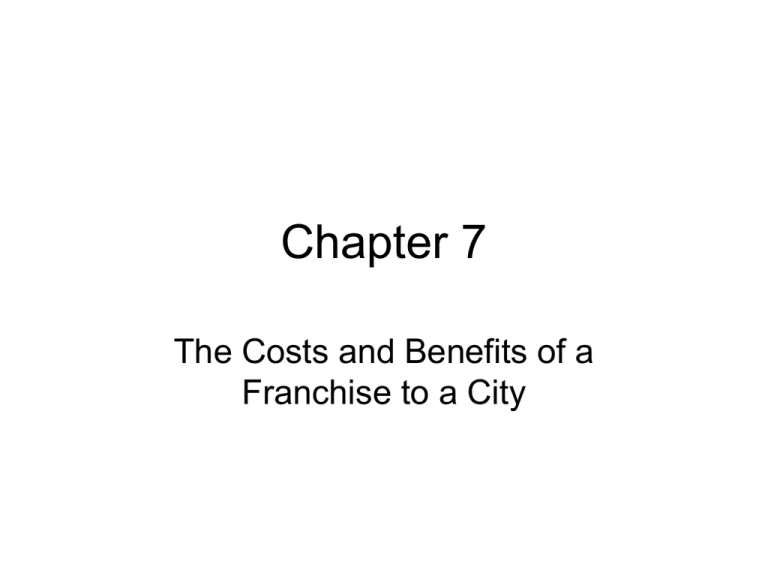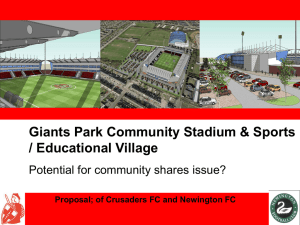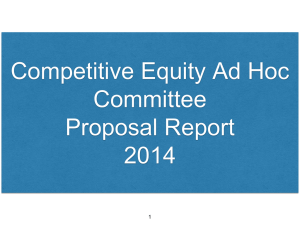Public Finance - Ken Farr (GCSU)
advertisement

Chapter 7 The Costs and Benefits of a Franchise to a City Stadium Costs and Revenues • Revenues for municipally-owned facilities seldom cover costs – Typical revenues • Rental Payments from teams • Share of Concessions, Parking, Luxury Boxes, etc. • Precise arrangements vary by facility – Typical costs • • • • Standard operating costs (labor, utilities, etc) Depreciation (facility will eventually be worthless) Opportunity Cost: Could have invested $$ elsewhere Foregone tax revenue – city can’t pay itself When Cities Pay for Stadiums • Suppose a city issues 30-year bonds at 3.5% interest to pay for a $500M stadium – It must make $27.2M/year to break even – Calculations: • • • • Payment Cost [1 (1 r) t ] r Payment = Required annual payment Cost = Cost of stadium r = Annual interest rate t = Term of loan in years • Most cities do not come close to break-even – Cities look beyond profit and loss (projects may still be good idea) – Markets often fail Teams Bring Cities Direct Benefits • The big idea is that a team: • Brings people to town from elsewhere – They spend money in city where sports team is located rather than in their own city – “Exports” to other municipalities rise • Causes local residents “spend more” locally – “Imports” from other cities fall (i.e., locals travel less to other towns for entertainment) • Net exports (exports minus imports) rise The Direct Impact Is Often Overstated • Must count only new spending – Much spending on teams is just reallocated – It would have been spent on another local activity • Teams are often conduits – not a magnets – Revenue comes in – but also goes out – Team pays salaries to players who live elsewhere – Items sold at concessions are typically made elsewhere The Direct Benefits of Sports Teams are Small • MLB generates less revenue than the company “Fruit of the Loom” • Denver and Philadelphia have 4 major sports teams within their city limits; Chicago has 5 teams – All the teams combined in each city account for less than ½ of 1% of total personal income in each city Indirect Effects • Teams have a bigger impact than just the direct impact – – – – Direct effects are like throwing a pebble in a lake The pebble generates ripples across the lake The impact of a team spreads throughout the economy Generates externalities (positive/negative) Externalities and Sports Franchises • Externalities are the impact of an action on a third party – Private firms do not take third party impacts into account – It might not even know there was an impact • Externalities can be negative – What you do hurts me – You don’t compensate me for my pain – Facilities can bring crime, noise, and congestion • Externalities can be positive – What you do helps me – I don’t compensate you for providing this benefit – Facilities add to city’s income, employment, & tax revenue The Impact of A Negative Externality • Firms’ have a private supply curve Sp P – Based on the cost of inputs • Intersection with Demand yields market outcome: Pp and Qp • But Sp might understate costs Sp – Some costs are borne by 3rd Pp parties – Firm does not compensate them – It might not even know these costs exist D QP Q The Impact of A Negative Externality • Pollution is a social cost P – Imposed on third party – Not part of supply decision Ss • Supply curve actually Ss – Includes private & social costs • Socially optimal outcome is Ps,Qs • The market “fails” – Quantity is too high (QP>QS) – Price is too low (PP<PS) – Producers and consumers benefit at the expense of others – Government can impose taxes to reduce quantity to Qs Sp Ps Pp D Qs QP Q Impact of Positive Externality • As before, producers weigh private costs and benefits P – Private benefits are to consumers of output – Sets demand at Dp • Market outcome is PP,QP S Pp Dp QP Q The Impact of a Positive Externality • Social benefits might exceed private benefits • Demand curve is actually DS P – Quantity is too low (QP<QS) – Price is too low (PP<PS) • Market fails • What can government do? – Provide tax breaks – Subsidize production – This is the justification for stadium subsidies S PS PP Ds Dp QP QS Q Indirect Effects and The Multiplier • For example, the direct benefit spending generates additional income • And the additional incomes cause more spending The Ripple Effect and the Multiplier • Ripples in a lake slowly fade away • The same is true for spending – The impact on income and expenditure gradually fades to zero – How to measure the size of the ripples? • The key is the Marginal Propensity to Consume (MPC) – The MPC shows how much of added income a consumer spends (DC/DY) – The MPS shows how much of added income a consumer saves (DS/DY) – Bigger MPC bigger ripples bigger multiplier • Note: MPC + MPS = 1 or MPS = 1-MPC The Arithmetic of the Multiplier • Let X = initial expenditure Y = total change in income – We know that MPC<1 – Therefore, Y = X(simple multiplier) • The simple multiplier = 1/(1-MPC) = 1/MPS – If the MPC=0.75 then the multiplier=4 • A $43M direct spending impact has a total induced impact of $172M The Multiplier for a Sports Franchise • Much of a franchise’s income goes to players – Players have more reason to save than others • The wealthy save more/spend less of each added dollar of income • Athletes’ high incomes last only a few years – more reason to save – Athletes’ low MPC reduces ripples & multiplier • Much income leaks out of the local area – Few players & executives live in town – Leakages are especially severe in smaller cities • People spend their higher incomes elsewhere – Multipliers are greater for larger cities • More income is spent locally • Local multipliers are likely much closer to 1 than 4 Are Sports Franchises a Good Idea? • “Although the consensus among economists is that cities do not come out ahead in the sports franchise game, some cities clearly do better than others.” Why? • Larger cities have more people who benefit, directly or indirectly, from having a team. • Bigger cities have a larger multiplier. • Special Events (Super Bowl, Olympics, World Cup) (?) A Public Choice Perspective • If cities don’t gain significantly from sports teams, then their spending millions of dollars on facilities for the teams seems to defy economic logic! Why do they do this? • Economists have developed an area of economic thought called Public Choice Theory (James Buchanan, Gordon Tullock, among others) that helps to explain. • Politicians act “economically” – They pursue their own self-interest – This means they act to maximize their political fortunes • Helps to explain public funding of stadiums – Why it happens even if it is not economically feasible The Power of Interest Groups • Interest groups have – Well-defined goals – Access to political power • This gives them an advantage – They can identify beneficial policies – They can organize to lobby for those policies • The impact on the majority of people is harder to identify • Example: construction employees (unions) and stadiums vs. average citizen Is this way of making decisions good or bad? • Benefits vs. Costs • For example: Unions in Wisconsin • Does this ever result in good outcomes? Why Majority Rule Might Not Be Good for the Economy • Majority rule might not maximize social welfare • Consider Pennsylvania’s dilemma in 2000 – Philadelphia (benefits east Penn.) and Pittsburgh (benefits west Penn.) wanted stadiums – Assume a stadium brings large local benefits and slightly higher taxes throughout the state • Majority rule says each stadium gets only 1/3 of the votes – Western and central legislators oppose Philadelphia – Eastern and central legislators oppose Pittsburgh – Even if overall benefits outweigh the overall costs The Benefits of Logrolling • By trading votes – “logrolling” – politicians may vote for both projects. • Legislators from East and West agree to vote for the other’s stadium • Both stadiums are built even though 2/3 actually oppose “each” project individually • Is this outcome good or bad for Pennsylvania? Table 7.2 (page 227) How Logrolling can Improve Social Well-Being Region Payoff to Proposal #1 Payoff to Proposal #2 East +$10 Million -$2 Million Central -$2 Million -$2 Million West -$2 Million +$10 Million Overall Net Impact +$6 Million +$6 Million Public Good & Teams • Teams serve as “civic icons” – Provide a sense of identity to residents – “And now, YOUR Atlanta Braves…” • Olympics have propaganda value – Cities and nations can demonstrate their power, prosperity and international position How To Pay for Facilities? • Localities can borrow money – But this only delays taxation – Eventually they have to pay off the loan • What is the best way to raise revenue? Cities can raise a variety of different taxes. • They frequently use sales taxes – Tax on the sale of an item – Ramsey rule for efficient sales taxes • Efficient tax minimizes deadweight loss • Tax should be inversely related to the elasticity of demand How Sales Taxes Work • Assume a per unit tax of $10 on hotel rooms • Sales tax creates “two” supply curves – Consumer sees S’ • Hotel room that had cost Pe now costs Pe+$10 – Producer sees S • Does not receive the extra payment P Pe’ S’ D $10 S Pe • Pe’ < Pe + $10 – Price rises by less than $10 Q Who Pays the Tax? Out of town visitors? • Consumers pay some of the tax – Pe’ > Pe • Hotels pay some of the tax – Pe’ < Pe + $10 • Trying to export ALL the tax burden to outof-town hotel guests will not work The Burden of a Sales Tax • The “true” cost of a sales tax is not the dollars paid • It is the deadweight loss • To see this, assume that, before the tax P D S Pe – The market is at (Qe, Pe) – Consumer Surplus is shaded orange Qe Q The Burden of a Sales Tax • Before tax – Market at (Qe, Pe) – Consumer Surplus is shaded orange – Producer Surplus is shaded red P D S • Gain to society is the sum of the two Q The Burden of a Sales Tax • Sales taxes shift the supply curve – Price rises – Quantity falls P D S’ S • Consumer surplus falls Q The Burden of a Sales Tax • Sales taxes shift the supply curve – Price rises – Quantity falls P D S’ S • Consumer surplus falls • Producer surplus falls Q The Burden of a Sales Tax • Part of loss in consumer and producer surplus is a P transfer • Green rectangle is tax revenue D S’ S – – – – Area = Tax * Quantity sold Lost by consumers Lost by producers But gained by others in society – Not a net loss overall Q The Burden of a Sales Tax • Part of consumer & producer surplus just disappears – Consumers buy less – Producers sell less P D S’ S • White triangle is a deadweight loss – – – – Lost by producers Lost by consumers Not gained by anyone A net loss to society Q Minimizing the Deadweight Loss • Ramsey rule says to tax more inelastic goods • The demand for dialysis is very inelastic (say perfectly inelastic) D P S’ S – Assume it is zero – D is a vertical line • Deadweight loss is 0 – Consumers still buy Q0 – Producers still sell Q0 • Should we tax dialysis? Q0 Q Tax Fairness • Taxing dialysis seems “unfair” using current social values • How do we judge fairness • We have two basic fairness criteria for taxes – Horizontal equity • People benefitting the most from a public project should pay the most in taxes (dialysis tax?) – Vertical equity: • Ability to pay—higher income people should bear more of the tax burden of a project (hotel tax?) Incremental Financing • Doesn’t impose new taxes • Belief that additional tax revenue will be generated from a public project – San Diego expects hotel stays to rise because of PETCO Park – Hotel tax revenue will rise as well – The added tax revenue will pay for the ballpark • It assumes a sustained rise in hotel revenue! Evidence doesn’t support this. Ideas why? Milwaukee Gains by Thinking Big (Taxes that Broaden the Burden) • Funded Miller Park with 5-county sales tax • Issues with such a sales tax – People may look outside the county to make purchases. – Vertical & horizontal issues • The poor pay a higher percentage of their income than the rich (regressive tax) • Those who pay the tax might not attend games • On the other hand, the wider tax may reduce inequities by: • Wealthy suburbanites help pay for the project • Wealthy suburbanites are the largest beneficiaries Seattle Gains by Thinking Small • Put sales .5% tax on restaurants & bars in King County – Tax paid by businesses that benefit from the stadium – A bit too broad • Hits restaurants across county as well as sports bars • Put 5% sales tax on tickets to stadium – Gets at direct beneficiaries • Put 2% sales tax on rental cars – Tried to export burden but has problems outlined above The Benefits of Debt • Tax laws give cities an advantage – Income earned on Municipal bonds are tax free – Lower tax burden means cities can offer less interest • Helps reduce tax burden on city residents • Increases tax burden on taxpayers in other states • Borrowing also “exports” the tax burden to later generations – This is okay if later generations also benefit – They do not benefit if they pay for an empty stadium – Pittsburgh residents were paying for Three Rivers Stadium after it was demolished






